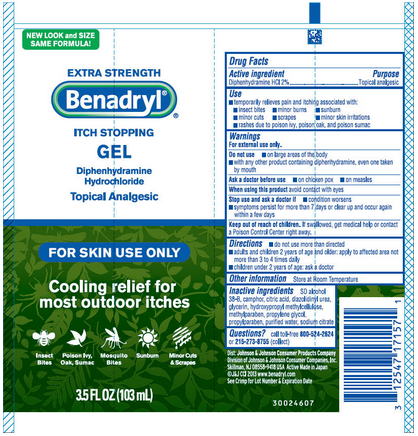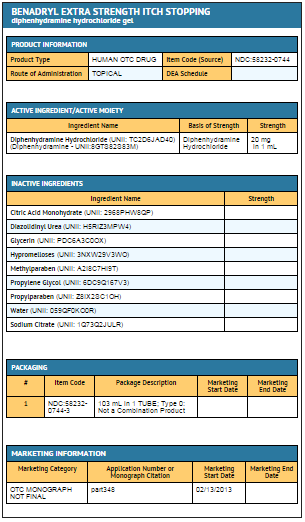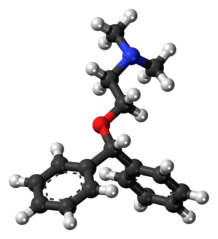Diphenhydramine (topical)
Editor-In-Chief: C. Michael Gibson, M.S., M.D. [1]; Associate Editor(s)-in-Chief: Adeel Jamil, M.D. [2]
Disclaimer
WikiDoc MAKES NO GUARANTEE OF VALIDITY. WikiDoc is not a professional health care provider, nor is it a suitable replacement for a licensed healthcare provider. WikiDoc is intended to be an educational tool, not a tool for any form of healthcare delivery. The educational content on WikiDoc drug pages is based upon the FDA package insert, National Library of Medicine content and practice guidelines / consensus statements. WikiDoc does not promote the administration of any medication or device that is not consistent with its labeling. Please read our full disclaimer here.
NOTE: Most over the counter (OTC) are not reviewed and approved by the FDA. However, they may be marketed if they comply with applicable regulations and policies. FDA has not evaluated whether this product complies.
Overview
Diphenhydramine (topical) is an analgesic and antihistamine that is FDA approved for the treatment of pain and itching associated with insect bites, minor burns, sunburn, minor cuts, scrapes, minor skin irritations, rashes due to poison ivy, poison oak, and poison sumac. Common adverse reactions include xerostomia, sedation, and dizziness.
Adult Indications and Dosage
FDA-Labeled Indications and Dosage (Adult)
- temporarily relieves pain and itching associated with:
- insect bites
- minor burns
- sunburn
- minor cuts
- scrapes
- minor skin irritations
- rashes due to poison ivy, poison oak, and poison sumac
Dosing Information
- do not use more than directed
- adults and children 2 years of age and older: apply to affected area not more than 3 to 4 times daily
- children under 2 years of age: ask a doctor
Off-Label Use and Dosage (Adult)
Guideline-Supported Use
There is limited information regarding Off-Label Guideline-Supported Use of Diphenhydramine (topical) in adult patients.
Non–Guideline-Supported Use
There is limited information regarding Off-Label Non–Guideline-Supported Use of Diphenhydramine (topical) in adult patients.
Pediatric Indications and Dosage
FDA-Labeled Indications and Dosage (Pediatric)
There is limited information regarding Diphenhydramine (topical) FDA-Labeled Indications and Dosage (Pediatric) in the drug label.
Off-Label Use and Dosage (Pediatric)
Guideline-Supported Use
There is limited information regarding Off-Label Guideline-Supported Use of Diphenhydramine (topical) in pediatric patients.
Non–Guideline-Supported Use
There is limited information regarding Off-Label Non–Guideline-Supported Use of Diphenhydramine (topical) in pediatric patients.
Contraindications
There is limited information regarding Diphenhydramine (topical) Contraindications in the drug label.
Warnings
- For external use only.
Do not use
- on large areas of the body
- with any other product containing diphenhydramine, even one taken by mouth
Ask a doctor before use
- on chicken pox
- on measles
When using this product avoid contact with eyes
Stop use and ask a doctor if
- condition worsens
- symptoms persist for more than 7 days or clear up and occur again within a few days
Keep out of reach of children
- If swallowed, get medical help or contact a Poison Control Center right
Adverse Reactions
Clinical Trials Experience
There is limited information regarding Diphenhydramine (topical) Clinical Trials Experience in the drug label.
Postmarketing Experience
There is limited information regarding Diphenhydramine (topical) Postmarketing Experience in the drug label.
Drug Interactions
There is limited information regarding Diphenhydramine (topical) Drug Interactions in the drug label.
Use in Specific Populations
Pregnancy
Pregnancy Category (FDA):
There is no FDA guidance on usage of Diphenhydramine (topical) in women who are pregnant.
Pregnancy Category (AUS):
There is no Australian Drug Evaluation Committee (ADEC) guidance on usage of Diphenhydramine (topical) in women who are pregnant.
Labor and Delivery
There is no FDA guidance on use of Diphenhydramine (topical) during labor and delivery.
Nursing Mothers
There is no FDA guidance on the use of Diphenhydramine (topical) in women who are nursing.
Pediatric Use
There is no FDA guidance on the use of Diphenhydramine (topical) in pediatric settings.
Geriatic Use
There is no FDA guidance on the use of Diphenhydramine (topical) in geriatric settings.
Gender
There is no FDA guidance on the use of Diphenhydramine (topical) with respect to specific gender populations.
Race
There is no FDA guidance on the use of Diphenhydramine (topical) with respect to specific racial populations.
Renal Impairment
There is no FDA guidance on the use of Diphenhydramine (topical) in patients with renal impairment.
Hepatic Impairment
There is no FDA guidance on the use of Diphenhydramine (topical) in patients with hepatic impairment.
Females of Reproductive Potential and Males
There is no FDA guidance on the use of Diphenhydramine (topical) in women of reproductive potentials and males.
Immunocompromised Patients
There is no FDA guidance one the use of Diphenhydramine (topical) in patients who are immunocompromised.
Administration and Monitoring
Administration
There is limited information regarding Diphenhydramine (topical) Administration in the drug label.
Monitoring
There is limited information regarding Diphenhydramine (topical) Monitoring in the drug label.
IV Compatibility
There is limited information regarding the compatibility of Diphenhydramine (topical) and IV administrations.
Overdosage
There is limited information regarding Diphenhydramine (topical) overdosage. If you suspect drug poisoning or overdose, please contact the National Poison Help hotline (1-800-222-1222) immediately.
Pharmacology
Mechanism of Action
There is limited information regarding Diphenhydramine (topical) Mechanism of Action in the drug label.
Structure
There is limited information regarding Diphenhydramine (topical) Structure in the drug label.
Pharmacodynamics
There is limited information regarding Diphenhydramine (topical) Pharmacodynamics in the drug label.
Pharmacokinetics
There is limited information regarding Diphenhydramine (topical) Pharmacokinetics in the drug label.
Nonclinical Toxicology
There is limited information regarding Diphenhydramine (topical) Nonclinical Toxicology in the drug label.
Clinical Studies
There is limited information regarding Diphenhydramine (topical) Clinical Studies in the drug label.
How Supplied
There is limited information regarding Diphenhydramine (topical) How Supplied in the drug label.
Storage
- Store at Room Temperature
Images
Drug Images
{{#ask: Page Name::Diphenhydramine (topical) |?Pill Name |?Drug Name |?Pill Ingred |?Pill Imprint |?Pill Dosage |?Pill Color |?Pill Shape |?Pill Size (mm) |?Pill Scoring |?NDC |?Drug Author |format=template |template=DrugPageImages |mainlabel=- |sort=Pill Name }}
Package and Label Display Panel
PRINCIPAL DISPLAY PANEL - 103 ML TUBE LABEL
NEW LOOK and SIZE SAME FORMULA!
EXTRA STRENGTH
Benadryl®
ITCH STOPPING GEL Diphenhydramine Hydrochloride
FOR SKIN USE ONLY
Cooling relief for Most outdoor itches
Insect Bites
Poison Ivy, Oak, Sumac
Mosquito Bites
Sunburn
Minor Cuts & Scrapes
3.5 FL OZ (103 mL)


{{#ask: Label Page::Diphenhydramine (topical) |?Label Name |format=template |template=DrugLabelImages |mainlabel=- |sort=Label Page }}
Patient Counseling Information
There is limited information regarding Diphenhydramine (topical) Patient Counseling Information in the drug label.
Precautions with Alcohol
Alcohol-Diphenhydramine (topical) interaction has not been established. Talk to your doctor about the effects of taking alcohol with this medication.
Brand Names
- Benadryl
Look-Alike Drug Names
There is limited information regarding Diphenhydramine (topical) Look-Alike Drug Names in the drug label.
Drug Shortage Status
Price
References
The contents of this FDA label are provided by the National Library of Medicine.
- ↑ Paton DM, Webster DR (1985). "Clinical pharmacokinetics of H1-receptor antagonists (the antihistamines)". Clin. Pharmacokinet. 10 (6): 477–97. doi:10.2165/00003088-198510060-00002. PMID 2866055.
- ↑ "Showing Diphenhydramine (DB01075)". DrugBank. Retrieved 5 September 2009.
- ↑ 3.0 3.1 3.2 Simons KJ, Watson WT, Martin TJ, Chen XY, Simons FE (July 1990). "Diphenhydramine: pharmacokinetics and pharmacodynamics in elderly adults, young adults, and children". J. Clin. Pharmacol. 30 (7): 665–71. doi:10.1002/j.1552-4604.1990.tb01871.x. PMID 2391399.
- ↑ Garnett WR (February 1986). "Diphenhydramine". Am. Pharm. NS26 (2): 35–40. PMID 3962845.

